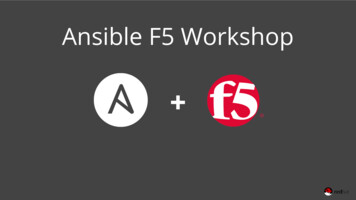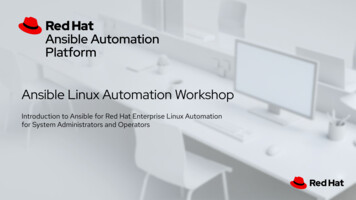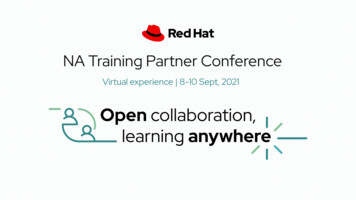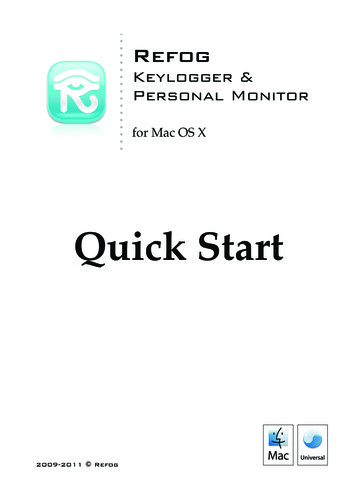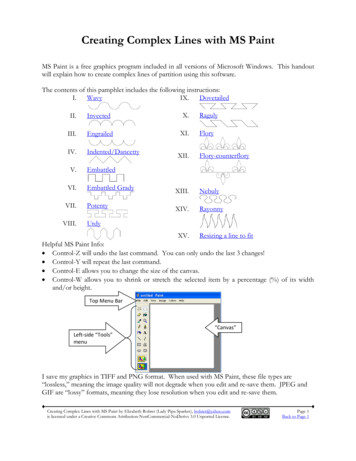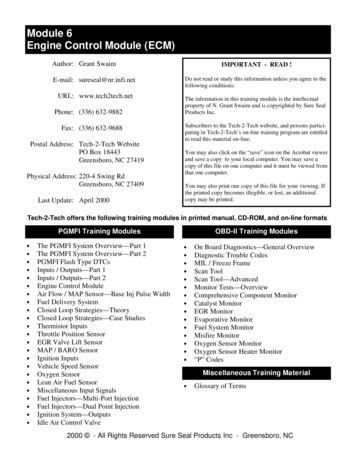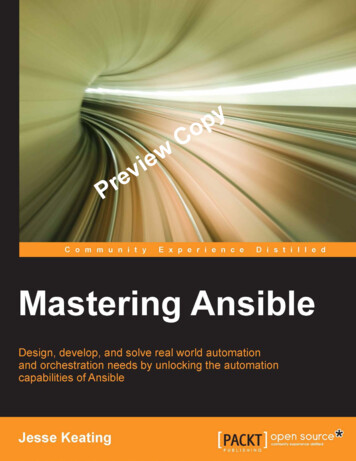
Transcription
weviCypoerP[1]
Mastering AnsibleDesign, develop, and solve real world automationand orchestration needs by unlocking the automationcapabilities of AnsibleJesse KeatingBIRMINGHAM - MUMBAI
Mastering AnsibleCopyright 2015 Packt PublishingAll rights reserved. No part of this book may be reproduced, stored in a retrievalsystem, or transmitted in any form or by any means, without the prior writtenpermission of the publisher, except in the case of brief quotations embedded incritical articles or reviews.Every effort has been made in the preparation of this book to ensure the accuracy ofthe information presented. However, the information contained in this book is soldwithout warranty, either express or implied. Neither the authornor Packt Publishing,and its dealers and distributors will be held liable for any damages caused or allegedto be caused directly or indirectly by this book.Packt Publishing has endeavored to provide trademark information about all of thecompanies and products mentioned in this book by the appropriate use of capitals.However, Packt Publishing cannot guarantee the accuracy of this information.First published: November 2015Production reference:1191115Published by Packt Publishing Ltd.Livery Place35 Livery StreetBirmingham B32PB, UK.ISBN 978-1-78439-548-3www.packtpub.com
CreditsAuthorJesse KeatingReviewersRyan EschingerProject CoordinatorNidhi JoshiProofreaderSafis EditingSreenivas MakamTim RuppSawant ShahPatrik UytterhoevenAcquisition EditorMeeta RajaniContent Development EditorZeeyan PinheiroTechnical EditorRohan Uttam GosaviCopy EditorPranjali ChuryIndexerMonica Ajmera MehtaGraphicsDisha HariaProduction CoordinatorArvindkumar GuptaCover WorkArvindkumar Gupta
About the AuthorJesse Keating is an accomplished Ansible user, contributor, and presenter. He hasbeen an active member of the Linux and open source communities for over 15 years.He has first-hand experience with a variety of IT activities, software development,and large-scale system administration. He has presented at numerous conferencesand meet-ups, and he has written many articles on a variety of topics.His professional Linux career started with Pogo Linux as a Lead Linux Engineerhandling many duties, including building and managing automated installationsystems. For 7 years, Jesse served at the Fedora Release Engineer as a senior softwareengineer at Red Hat. In 2012, he joined Rackspace to help manage Rackspace's publicCloud product, where he introduced the use of Ansible for the large-scale automationand orchestration of OpenStack-powered Clouds. Currently, he is a senior softwareengineer and the OpenStack release lead at Blue Box, an IBM company, where hecontinues to utilize Ansible to deploy and manage OpenStack Clouds.He has worked as technical editor on Red Hat Fedora and Enterprise Linux 4Bible, A Practical Guide to Fedora and Red Hat Enterprise Linux 4th Edition, Python:Create-Modify-Reuse, and Practical Virtualization Solutions: Virtualization fromthe Trenches. He has also worked as a contributing author on Linux Toys II,and Linux Troubleshooting Bible. You can find Jesse on Twitter using the handle@iamjkeating, and find his musings that require more than 140 characterson his blog at https://derpops.bike.
AcknowledgmentI'd like to thank my wife—my partner in crime, my foundation, my everything. Shewillingly took the load of our family so that I could hide away in a dark corner towrite this book. Without her, it would never have been done. She was also there topoke me, not so gently, to put down the distractions at hand and go write! Thankyou Jessie, for everything. I'd like to to thank my boys too, Eamon and Finian, forgiving up a few (too many) evenings with their daddy while I worked to completeone chapter or another. Eamon, it was great to have you so interested in what itmeans to write a book. Your curiosity inspires me! Fin, you're the perfect remedy forspending too much time in serious mode. You can always crack me up! Thank you,boys for sharing your father for a bit.I'd also like to thank all my editors, reviewers, confidants, coworkers past andpresent, and just about anybody who would listen to my crazy ideas, or read ablurb I put on the page. Your feedback kept me going, kept me correct, and keptmy content from being completely adrift.
About the ReviewersRyan Eschinger is an independent software consultant with over 15 years ofexperience in operations and application development. He has a passion for helpingbusinesses build and deploy amazing software. Using tools such as Ansible, hespecializes in helping companies automate their infrastructure, establish automatedand repeatable deployments, and build virtualized development environments thatare consistent with production. He has worked with organizations of all shapes,sizes, and technical stacks. He's seen it all—good and bad—and he loves what hedoes. You can find him in one of the many neighborhood coffee shops in Brooklyn,NY, or online at http://ryaneschinger.com/.Sreenivas Makam is currently working as a senior engineering managerat Cisco Systems, Bangalore. He has a master's degree in electrical engineeringand around 18 years of experience in the networking industry. He has workedon both start-ups and big established companies. His interests include SDN, NFV,Network Automation, DevOps, and Cloud technologies. He also likes to try outand follow open source projects in these areas. You can find him on his blog athttps://sreeninet.wordpress.com/.
Tim Rupp has been working in various fields of computing for the last 10 years. Hehas held positions in computer security, software engineering, and most recently, inthe fields of Cloud computing and DevOps.He was first introduced to Ansible while at Rackspace. As part of the Cloudengineering team, he made extensive use of the tool to deploy new capacity for theRackspace Public Cloud. Since then, he has contributed patches, provided supportfor, and presented on Ansible topics at local meetups.He is currently stationed at F5 Networks, where he is involved in Solutiondevelopment as a senior software engineer. Additionally, he spends time assistingcolleagues in various knowledge-sharing situations revolving around OpenStackand Ansible.I'd like to thank my family for encouraging me to take risks andsupporting me along the way. Without their support, I would havenever come out of my shell to explore new opportunities. I'd alsolike to thank my girlfriend for putting up with my angry beavermoments as I balance work with life.Sawant Shah is a passionate and experienced full-stack application developer witha formal degree in computer science.Being a software engineer, he has focused on developing web and mobile applicationsfor the last 9 years. From building frontend interfaces and programming applicationbackend as a developer to managing and automating service delivery as a DevOpsengineer, he has worked at all stages of an application and project's lifecycle.He is currently spearheading the web and mobile projects division at the ExpressMedia Group—one of the country's largest media houses. His previous experienceincludes leading teams and developing solutions at a software house, a BPO, anon-profit organization, and an Internet startup.He loves to write code and keeps learning new ways to write optimal solutions.He blogs his experiences and opinions regarding programming and technologyon his personal website, http://www.sawantshah.com, and on Medium,https://medium.com/@sawant.You can follow him on Twitter, where heshares learning resources and other useful tech material at @sawant.
Patrik Uytterhoeven has over 16 years of experience in IT. Most of this time wasspent on HP Unix and Red Hat Linux. In late 2012, he joined Open-Future, a leadingopen source integrator and the first Zabbix reseller and training partner in Belgium.When he joined Open-Future, he gained the opportunity to certify himselfas a Zabbix Certified trainer. Since then, he has provided training and publicdemonstrations not only in Belgium but also around the world, in countries suchas the Netherlands, Germany, Canada, and Ireland. His next step was to write abook about Zabbix. Zabbix Cookbook was born in March 2015 and was published byPackt Publishing.As he also has a deep interest in configuration management, he wrote some Ansibleroles for Red Hat 6.x and 7.x to deploy and update Zabbix. These roles, and someothers, can be found in the Ansible Galaxy at https://galaxy.ansible.com/list#/users/1375.He is also a technical reviewer of Learning Ansible and the upcoming book, AnsibleConfiguration Management, Second Edition, both by Packt Publishing.
www.PacktPub.comSupport files, eBooks, discount offers, and moreFor support files and downloads related to your book, please visit www.PacktPub.com.Did you know that Packt offers eBook versions of every book published, with PDFand ePub files available? You can upgrade to the eBook version at www.PacktPub.comand as a print book customer, you are entitled to a discount on the eBook copy. Get intouch with us at service@packtpub.com for more details.At www.PacktPub.com, you can also read a collection of free technical articles, signup for a range of free newsletters and receive exclusive discounts and offers on Packtbooks and ion/packtlibDo you need instant solutions to your IT questions? PacktLib is Packt's online digitalbook library. Here, you can search, access, and readPackt's entire library of books.Why subscribe? Fully searchable across every book published by Packt Copy and paste, print, and bookmark content On demand and accessible via a web browserFree access for Packt account holdersIf you have an account with Packt atwww.PacktPub.com, you can use this to accessPacktLib today and view 9 entirely free books. Simply use your login credentials forimmediate access.
Table of ContentsPrefaceChapter 1: System Architecture and Design of AnsibleAnsible version and configurationInventory parsing and data sourcesThe static inventoryInventory variable dataDynamic inventoriesRun-time inventory additionsInventory limitingPlaybook parsingOrder of operationsRelative path assumptionsPlay behavior keysHost selection for plays and tasksPlay and task namesModule transport and executionModule referenceModule argumentsModule transport and executionTask performanceVariable types and locationVariable typesAccessing external dataVariable precedencePrecedence tra-varsConnection variablesMost everything elseThe rest of the inventory variables29292930[i]
Table of ContentsFacts discovered about a systemRole defaults3030Merging hashesSummaryChapter 2: Protecting Your Secrets with AnsibleEncrypting data at restThings Vault can encryptCreating new encrypted filesThe password promptThe password fileThe password scriptEncrypting existing filesEditing encrypted filesPassword rotation for encrypted filesDecrypting encrypted filesExecuting ansible-playbook with Vault-encrypted filesProtecting secrets while operatingSecrets transmitted to remote hostsSecrets logged to remote or local filesSummaryChapter 3: Unlocking the Power of Jinja2 TemplatesControl structuresConditionalsInline 494952Loops53Macros58Filtering loop itemsLoop indexing5455Macro variables59Data manipulationSyntaxUseful built-in filters676768defaultcountrandomround68696969Useful Ansible provided custom filters69Omitting undefined arguments76Filters related to task statusshuffleFilters dealing with path namesBase64 encodingSearching for content[ ii ]7071717375
Table of ContentsPython object methods77String methodsList methodsint and float methods777878Comparing r 4: Controlling Task Conditions81Chapter 5: Composing Reusable Ansible Content with Roles95Defining a failureIgnoring errorsDefining an error conditionDefining a changeSpecial handling of the command familySuppressing a changeSummaryTask, handler, variable, and playbook include conceptsIncluding tasksPassing variable values to included tasksPassing complex data to included tasksConditional task includesTagging included tasks81818388909293969699101103105Including handlersIncluding variables107109Including playbooksRolesRole structure115115115Role dependencies118vars filesDynamic vars files inclusioninclude dulesDependenciesFiles and templatesPutting it all together116116116116117117117Role dependency variablesTagsRole dependency conditionals118119120[ iii ]
Table of ContentsRole application120Role sharing126Mixing roles and tasks123Ansible Galaxy126Summary131Chapter 6: Minimizing Downtime with Rolling Deployments133Chapter 7: Troubleshooting Ansible155In-place upgradesExpanding and contractingFailing fastThe any errors fatal optionThe max fail percentage optionForcing handlersMinimizing disruptionsDelaying a disruptionRunning destructive tasks only onceSummaryPlaybook logging and verbosityVerbosityLoggingVariable introspectionVariable sub elementsSubelement versus Python object 9162Debugging code executionDebugging local code163164Debugging remote code172Debugging inventory codeDebugging Playbook codeDebugging runner code164168169Debugging the action plugins176Summary177Chapter 8: Extending Ansible179Developing modulesThe basic module constructCustom modulesSimple module179180180181Module documentationProviding fact dataCheck mode184190191Developing pluginsConnection type pluginsShell plugins193193193[ iv ]
Table of ContentsLookup pluginsVars pluginsFact caching pluginsFilter pluginsCallback pluginsAction pluginsDistributing pluginsDeveloping dynamic inventory pluginsListing hostsListing host variablesSimple inventory ptimizing script performanceIndex206209[v]
PrefaceWelcome to Mastering Ansible, your guide to a variety of advanced features andfunctionality provided by Ansible, which is an automation and orchestration tool.This book will provide you with the knowledge and skills to truly understandhow Ansible functions at the fundamental level. This will allow you to master theadvanced capabilities required to tackle the complex automation challenges of todayand beyond. You will gain knowledge of Ansible workflows, explore use casesfor advanced features, troubleshoot unexpected behavior, and extend Ansiblethrough customization.What this book coversChapter 1, System Architecture and Design of Ansible, provides a detailed look at the insand outs of how Ansible goes about performing tasks on behalf of an engineer, howit is designed, and how to work with inventories and variables.Chapter 2, Protecting Your Secrets with Ansible, explores the tools available to encryptdata at rest and prevent secrets from being revealed at runtime.Chapter 3, Unlocking the Power of Jinja2 Templates, states the varied uses of theJinja2 templating engine within Ansible, and discusses ways to make the mostout of its capabilities.Chapter 4, Controlling Task Conditions, describes the changing of default behavior ofAnsible to customize task error and change conditions.Chapter 5, Composing Reusable Ansible Content with Roles, describes the approach tomove beyond executing loosely organized tasks on hosts to encapsulating cleanreusable abstractions to applying the specific functionality of a target set of hosts.Chapter 6, Minimizing Downtime with Rolling Deployments, explores the commondeployment and upgrade strategies to showcase relevant Ansible features.[ vii ]
PrefaceChapter 7, Troubleshooting Ansible, explores the various methods that can be employedto examine, introspect, modify, and debug the operations of Ansible.Chapter 8, Extending Ansible, discovers the various ways in which new capabilitiescan be added to Ansible via modules, plugins, and inventory sources.What you need for this bookTo follow the examples provided in this book, you will need access to a computerplatform capable of running Ansible. Currently, Ansible can be run from anymachine with Python 2.6 or 2.7 installed (Windows isn't supported for the controlmachine). This includes Red Hat, Debian, CentOS, OS X, any of the BSDs, and so on.This book uses the Ansible 1.9.x series release.Ansible installation instructions can be found at http://docs.ansible.com/ansible/intro installation.html.Who this book is forThis book is intended for Ansible developers and operators who have an understandingof the core elements and applications but are now looking to enhance their skills inapplying automation using Ansible.ConventionsIn this book, you will find a number of text styles that distinguish between differentkinds of information. Here are some examples of these styles and an explanation oftheir meaning.Code words in text, database table names, folder names, filenames, file extensions,pathnames, dummy URLs, user input, and Twitter handles are shown as follows:"When ansible or ansible-playbook is directed at an executable file for aninventory source, Ansible will execute that script with a single argument, --list."A block of code is set as follows:- name: add new node into runtime inventoryadd host:name: newmastery.example.namegroups: webansible ssh host: 192.168.10.30[ viii ]
PrefaceNew terms and important words are shown in bold. Words that you see on the screen,for example, in menus or dialog boxes, appear in the text like this: "The first is anSSH feature, ControlPersist, which provides a mechanism to create persistent socketswhen first connecting to a remote host that can be reused in subsequent connections tobypass some of the handshaking required when creating a connection."Warnings or important notes appear in a box like this.Tips and tricks appear like this.Reader feedbackFeedback from our readers is always welcome. Let us know what you think aboutthis book—what you liked or disliked. Reader feedback is important for us as it helpsus develop titles that you will really get the most out of.To send us general feedback, simply e-mail feedback@packtpub.com, and mentionthe book's title in the subject of your message.If there is a topic that you have expertise in and you are interested in either writingor contributing to a book, see our author guide at www.packtpub.com/authors.Customer supportNow that you are the proud owner of a Packt book, we have a number of things tohelp you to get the most from your purchase.Downloading the example codeYou can download the example code files from your account at http://www.packtpub.com for all the Packt Publishing books you have purchased. If youpurchased this book elsewhere, you can visit http://www.packtpub.com/supportand register to have the files e-mailed directly to you.[ ix ]
PrefaceErrataAlthough we have taken every care to ensure the accuracy of our content, mistakesdo happen. If you find a mistake in one of our books—maybe a mistake in the text orthe code—we would be grateful if you could report this to us. By doing so, you cansave other readers from frustration and help us improve subsequent versions of thisbook. If you find any errata, please report them by visiting http://www.packtpub.com/submit-errata, selecting your book, clicking on the Errata Submission Formlink, and entering the details of your errata. Once your errata are verified, yoursubmission will be accepted and the errata will be uploaded to our website or addedto any list of existing errata under the Errata section of that title.To view the previously submitted errata, go to https://www.packtpub.com/books/content/support and enter the name of the book in the search field. The requiredinformation will appear under the Errata section.PiracyPiracy of copyrighted material on the Internet is an ongoing problem across allmedia. At Packt, we take the protection of our copyright and licenses very seriously.If you come across any illegal copies of our works in any form on the Internet, pleaseprovide us with the location address or website name immediately so that we canpursue a remedy.Please contact us at copyright@packtpub.com with a link to the suspectedpirated material.We appreciate your help in protecting our authors and our ability to bring youvaluable content.QuestionsIf you have a problem with any aspect of this book, you can contact us atquestions@packtpub.com, and we will do our best to address the problem.[x]
System Architecture andDesign of AnsibleThis chapter provides a detailed exploration of the architecture and design of howAnsible goes about performing tasks on your behalf. We will cover basic conceptsof inventory parsing and how the data is discovered, and then dive into playbookparsing. We will take a walk through module preparation, transportation, andexecution. Lastly, we will detail variable types and find out where variables can belocated, the scope they can be used for, and how precedence is determined whenvariables are defined in more than one location. All these things will be covered inorder to lay the foundation for mastering Ansible!In this chapter, we will cover the following topics: Ansible version and configuration Inventory parsing and data sources Playbook parsing Module transport and execution Variable types and locations Variable precedence[1]
System Architecture and Design of AnsibleAnsible version and configurationIt is assumed that you have Ansible installed on your system. There are manydocuments out there that cover installing Ansible in a way that is appropriate forthe operating system and version that you might be using. This book will assumethe use of the Ansible 1.9.x version. To discover the version in use on a system withAnsible already installed, make use of the version argument, that is, either ansibleor ansible-playbook:Note that ansible is the executable for doing ad-hoc one-taskexecutions and ansible-playbook is the executable that willprocess playbooks for orchestrating many tasks.The configuration for Ansible can exist in a few different locations, where the first filefound will be used. The search order changed slightly in version 1.5, with the neworder being: ANSIBLE CFG: This is an environment variable ansible.cfg: This is in the current directory ansible.cfg: This is in the user's home directory /etc/ansible/ansible.cfgSome installation methods may include placing a config file in one of these locations.Look around to check whether such a file exists and see what settings are in the fileto get an idea of how Ansible operation may be affected. This book will assume nosettings in the ansible.cfg file that would affect the default operation of Ansible.[2]
Chapter 1Inventory parsing and data sourcesIn Ansible, nothing happens without an inventory. Even ad hoc actions performedon localhost require an inventory, even if that inventory consists just of thelocalhost. The inventory is the most basic building block of Ansible architecture.When executing ansible or ansible-playbook, an inventory must be referenced.Inventories are either files or directories that exist on the same system that runsansible or ansible-playbook. The location of the inventory can be referenced atruntime with the –inventory-file (-i) argument, or by defining the path in anAnsible config file.Inventories can be static or dynamic, or even a combination of both, and Ansible isnot limited to a single inventory. The standard practice is to split inventories acrosslogical boundaries, such as staging and production, allowing an engineer to run a setof plays against their staging environment for validation, and then follow with thesame exact plays run against the production inventory set.Variable data, such as specific details on how to connect to a particular host in yourinventory, can be included along with an inventory in a variety of ways as well, andwe'll explore the options available to you.The static inventoryThe static inventory is the most basic of all the inventory options. Typically, a staticinventory will consist of a single file in the ini format. Here is an example of a staticinventory file describing a single host, mastery.example.name:mastery.example.nameThat is all there is to it. Simply list the names of the systems in your inventory. Ofcourse, this does not take full advantage of all that an inventory has to offer. If everyname were listed like this, all plays would have to reference specific host names, orthe special all group. This can be quite tedious when developing a playbook thatoperates across different sets of your infrastructure. At the very least, hosts shouldbe arranged into groups. A design pattern that works well is to arrange your systemsinto groups based on expected functionality. At first, this may seem difficult if youhave an environment where single systems can play many different roles, but that isperfectly fine. Systems in an inventory can exist in more than one group, and groupscan even consist of other groups! Additionally, when listing groups and hosts, it'spossible to list hosts without a group. These would have to be listed first, before anyother group is defined.[3]
System Architecture and Design of AnsibleLet's build on our previous example and expand our inventory with a few morehosts and some children]web[backend:children]dnsdatabaseWhat we have created here is a set of three groups with one system in each, andthen two more groups, which logically group all three together. Yes, that's right; youcan have groups of groups. The syntax used here is [groupname:children], whichindicates to Ansible's inventory parser that this group by the name of groupname isnothing more than a grouping of other groups. The children in this case are the namesof the other groups. This inventory now allows writing plays against specific hosts,low-level role-specific groups, or high-level logical groupings, or any combination.By utilizing generic group names, such as dns and database, Ansible plays canreference these generic groups rather than the explicit hosts within. An engineer cancreate one inventory file that fills in these groups with hosts from a preproductionstaging environment and another inventory file with the production versions of thesegroupings. The playbook content does not need to change when executing on eitherstaging or production environment because it refers to the generic group namesthat exist in both inventories. Simply refer to the right inventory to execute it in thedesired environment.Inventory variable dataInventories provide more than just system names and groupings. Data about thesystems can be passed along as well. This can include: Host-specific data to use in templates Group-specific data to use in task arguments or conditionals Behavioral parameters to tune how Ansible interacts with a system[4]
Chapter 1Variables are a powerful construct within Ansible and can be used in a variety ofways, not just the ways described here. Nearly every single thing done in Ansiblecan include a variable reference. While Ansible can discover data about a systemduring the setup phase, not all data can be discovered. Defining data with theinventory is how to expand the dataset. Note that variable data can come from manydifferent sources, and one source may override another source. Variable precedenceorder is covered later in this chapter.Let's improve upon our existing example inventory and add to it some variable data.We will add some host-specific data as well as group specific data:[web]mastery.example.name ansible ssh host hildren]dnsdatabase[web:vars]http port 88proxy timeout 5[backend:vars]ansible ssh port 314[all:vars]ansible ssh user ottoIn this example, we defined ansible ssh host for mastery.example.name to bethe IP address of 192.168.10.25. An ansible ssh host is a behavioral inventoryparameter, which is intended to alter the way Ansible behaves when operatingwith this host. In this case, the parameter instructs Ansible to connect to thesystem using the provided IP address rather than performing a DNS lookup on thename mastery.example.name. There are a number of other behavioral inventoryparameters, which are listed at the end of this section along with their intended use.[5]
System Architecture and Design of AnsibleOur new inventory data also provides group level variables for the web andbackend groups. The web group defines http port, which may be used in an nginxconfiguration file, and proxy timeout, which might be used to determine HAProxybehavior. The backend group makes use of another behavioral inventory parameterto instruct Ansible to connect to the hosts in this group using port 314 for SSH, ratherthan the default of 22.Finally, a construct is introduced that provides variable data across all the hosts inthe inventory by utilizing a built-in all group. Variables defined within this groupwill apply to every host in the inventory. In this particular example, we instructAnsible to log in as the otto user when connecting to the systems. This is also abehavioral change, as the Ansible default behavior is to log in as a user with thesame name as the user executing ansible or ansible-playbook on the control host.Here is a table of behavior inventory parameters and the behavior they intendto modify:Inventory parametersansible ssh hostansible ssh portansible ssh useransible ssh passBehaviourThis is the name of the host to connect to,if different from the alias you wish to giveto it.This is the SSH port number, if not 22.This is the default SSH username to use.This is the SSH password to use (this isinsecure, we strongly recommend using--ask-pass or the SSH keys)ansible sudo passThis is the su
and orchestration of OpenStack-powered Clouds. Currently, he is a senior software engineer and the OpenStack release lead at Blue Box, an IBM company, where he continues to utilize Ansible to deploy and manage OpenStack Clouds. He has worked as
